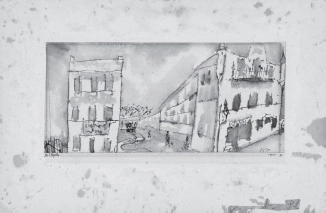From time to time the figure of a biblical prophet appeared in the strange light; people in brown tails carrying feathers and bows hurried around the room and a young man spoke in a deep, sonorous voice: ‘To be or not to be.’ Aside from that it was silent amid the lively commotion. Magnetic forces seemed to inhabit the depths of the temple. It became hard for us to walk. Ahead of us lay a range of portals – some larger, some smaller – all in a heavy, gold-flourished Baroque or Empire style. They were closed, but from behind them – perceptible amid the subterranean storm – came fine music. And opposite, at a great distance, an open, illuminated room became visible, from which a wealth of marble statues emitted their glow.
Beside us stood Mephisto. He trod on ahead up some steep, narrow stairs – it may have been a thousand steps. We stood on one of the temple’s elevated platforms. A wide, clear view of the earth spread out before us and we drank it in. But soon a stirring became discernible in this smooth, calm scene. It swelled and grew. The land appeared to surge in great waves. The sky darkened and contracted. It was as if the entire world drew together into this one point with terrifying force. While fleeing, we caught sight of torn laurel leaves strewn on the ground. Behind us resounded Mephisto’s bright laughter. We reached a narrow corridor that continued on for an inestimable distance. Suddenly Mephisto’s voice was with us again. Clearly and scornfully, but in a low voice, he seemed to ask a question: ‘To the mothers?’
—
Translated by Sebastian Truskolaski.
Fragment written c. 1906–12; unpublished in Benjamin’s lifetime. Gesammelte Schriften VII, 636–9.

Two Facades (Dwie fasady), 1911.
There once lived a merchant in a big, old city. His house stood in one of the very oldest parts of town, on a narrow, dirty little alley. And on this alley – where all the houses were so old that they could no longer stand alone and had to lean against each other – the merchant’s house was the oldest. But it was also the biggest. With its mighty, arched doorway and tall, curved windows made up of half-blind bullseye panes, and with the steep roof on which a number of narrow little skylights had been fitted, it looked quite strange – the house of the merchant, the last house on Mariengasse. This was a pious town and many of the houses had beautiful carvings of the holy virgin or some other saint above their doorways or under their roofs. On Mariengasse, too, every house had its saint – only the merchant’s house stood bare and grey without any adornments. Nobody lived in the big house except for the merchant and a small eight-year-old girl. The girl was not his daughter, but she lived with him; he brought her up and the child helped with the housekeeping. But how she came to live in the merchant’s house, nobody really knew.
1 comment